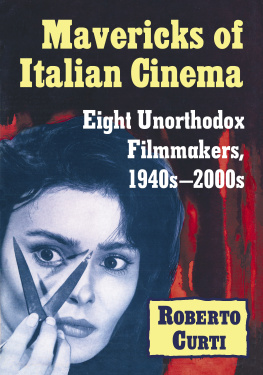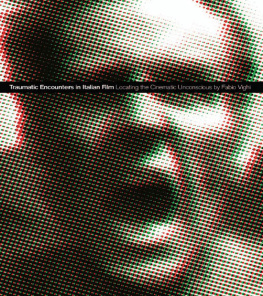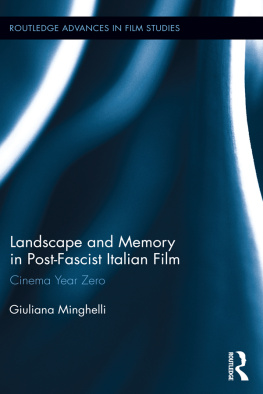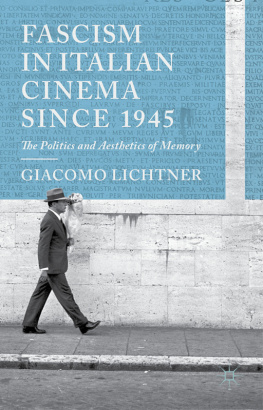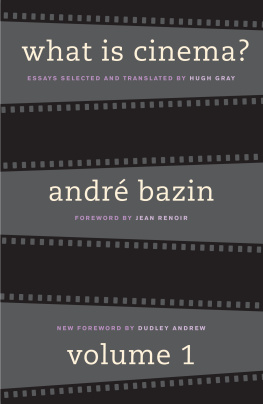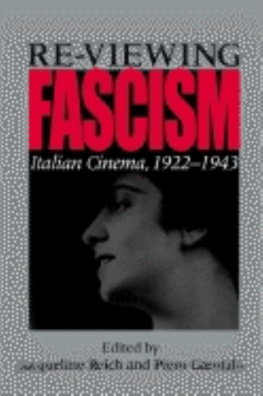Vital Crises in Italian Cinema
VITAL CRISES IN ITALIAN CINEMA
Iconography, Stylistics, Politics
P. Adams Sitney


Oxford University Press is a department of the University of Oxford.
It furthers the Universitys objective of excellence in research,
scholarship, and education by publishing worldwide.
Oxford New York
Auckland Cape Town Dar es Salaam Hong Kong Karachi
Kuala Lumpur Madrid Melbourne Mexico City Nairobi
New Delhi Shanghai Taipei Toronto
With offices in
Argentina Austria Brazil Chile Czech Republic France Greece
Guatemala Hungary Italy Japan Poland Portugal Singapore
South Korea Switzerland Thailand Turkey Ukraine Vietnam
Oxford is a registered trade mark of Oxford University Press
in the UK and certain other countries.
Published in the United States of America by
Oxford University Press
198 Madison Avenue, New York, NY 10016
1995, 2013 by P. Adams Sitney
First published by University of Texas Press, 1995
First paperback edition published by Oxford University Press, 2013
All rights reserved. No part of this publication may be reproduced,
stored in a retrieval system, or transmitted, in any form or by any means, without the
prior permission in writing of Oxford University Press, or as expressly permitted by law,
by license, or under terms agreed with the appropriate reproduction rights organization.
Inquiries concerning reproduction outside the scope of the above should be sent
to the Rights Department, Oxford University Press, at the address above.
You must not circulate this work in any other form
and you must impose this same condition on any acquirer.
Library of Congress Cataloging-in-Publication Data
Sitney, P. Adams.
Vital crises in Italian cinema: iconography, stylistics, politics / P. Adams Sitney.1st paperback ed.
p. cm.
Includes bibliographical references and index.
ISBN 978-0-19-986217-7 (pbk.: alk. paper)
1. Motion picturesItalyHistory and criticism. I. Title.
PN1993.5.I88S57 2013
791.430945dc23 2012029869
9 8 7 6 5 4 3 2 1
Printed in the United States of America
on acid-free paper
To Blake, Sky, Augusta, and Miranda
and in memory of Margie
cos mi si cambiaro in maggior feste
li fiori e le faville, s chio vidi
ambo le corti del ciel manifeste
PARADISO 30
CONTENTS
Although fifteen years have passed since the initial publication of this book, I remain so committed to the overall thesis and especially to the analyses of the individual films discussed here that I eagerly anticipate its return to print. I have added a brief discussion of the relation of Olmis Il posto to Fellinis I vittelloni, but otherwise the original text remains unaltered. The major supplement is a new chapter devoted to the achievements of Italian cinema in the violent days of 19771978. There I concentrate on two masterpieces focused on historical modes of pastoral education: the Tavianis Padre Padrone and Olmis Lalbero degli zoccoli.
In stubbornly reprinting my 1995 volume, I do not mean to suggest that the scholarship of Italian cinema has not flourished since then. In English alone there have been many distinguished books that have made significant contributions to the understanding of the periods and the films I discuss: Marcia Landys Italian Film, Noa Steimatskys Italian Locations: Inhabiting the Past in Postwar Cinema, Angelo Restivos The Cinema of Economic Miracles: Visuality and Modernization in the Italian Art Film, Henry Bacons Visconti: Explorations of Beauty and Decay, Carlo Testas edited collection The Films of Francesco Rosi, and Vincent F. Rocchios Cinema of Anxiety: A Psychoanalysis of Italian Neorealism. Furthermore, Christopher Wagstaffs Italian Neorealist Cinema: An Aesthetic Approach is an extraordinary, in-depth examination of Rossellinis Roma, citt aperta and Pais and De Sicas Ladri di biciclette, while Tag Gallaghers The Adventures of Roberto Rossellini is a monumental work unlikely to be superseded in my lifetime. At last, we also finally have an English translation of one of the works by the greatest historian of the Italian cinemaperhaps the greatest film historian of my generationGian Pier Brunetta: The History of Italian Cinema: A Guide to Italian Film from its Origins to the Twenty-first Century.
The debts I owe in preparing this new edition are considerable. My research was greatly facilitated by access to the Cineteca del Comune di Bologna where Anna Fiaccarini, the director of its Biblioteca Renzo Renzi, was always very helpful. My work in Italy was made both possible and pleasurable by the hospitality of Daniel Heller-Roazen and Oleg Tcherny in Venice. Linda Levinson, who accompanied me on two research trips, was both an inspiration and a sounding board for ideas. Princeton Universitys Committee on Research in the Humanities and Social Sciences helped to defray the costs of my travel to Italy, and Princetons Program in Visual Arts financed the creation of new film stills to use for reproductions in the book. Without the skill the photographer, Arunas Kulikauksas, and the help of Robert Haller, the librarian of Anthology Film Archives, that task would have been much more difficult.
Thanks to Pavle Levi and Scott Bukatman. I was invited to give the Christensen Distinguished Lecture at Stanford University in May 2009, where I received valuable responses to my chapter on the films of the late 1970s. While I was a Fellow of the American Academy in Berlin in 2011, I was able to complete that chapter.
My editors at Oxford University Press, Shannon McLachlan and Brendan ONeill, have been, as usual, both patient and helpful, as has been my loyal agent, Georges Borchardt.
This book is quite different in subject and origins from my other writings on film history, for it is neither polemical nor centered on my lifelong association with the American avant-garde cinema and its artists. It is the product of a passion and of the scholarship animated by that passion.
The three crucial films I discuss in the chapter called Annus Mirabilis had been fundamental in my formation as a teenage cinphile. So that when I first traveled to Italy, in 1963 as the director of an exposition of American avant-garde films, it was with great anticipation and inevitable disappointment that I glimpsed aspects of that great momentor vital crisis, to adapt Pasolinis phraseas it was waning. Yet it was only as the director of a second such exposition, while visiting Italy several times in 1967 and 1968, that I began to learn the language (which I never mastered) and study the history of that fecund period, realizing that it could not be understood without reference to the florescence of Italian cinema in the years immediately following the Second World War.
My fascination with those phases of Italian film history would not have resulted in a book had I not moved from my positions as Librarian of Anthology Film Archives and Assistant Professor of Cinema Studies at New York University, where I taught mainly avant-garde film or film theory, to Princeton University in 1980, where I had responsibility for the full range of film history. Of the many seminars and courses I presented in my first years there, none so excited me as a course in Italian films attended by four or five loyal and energetic students. Later I had the advantage of coteaching a version of that course with the Renaissance scholar David Quint, who both encouraged me in my work on Italian film and influenced my approach to the subject.


